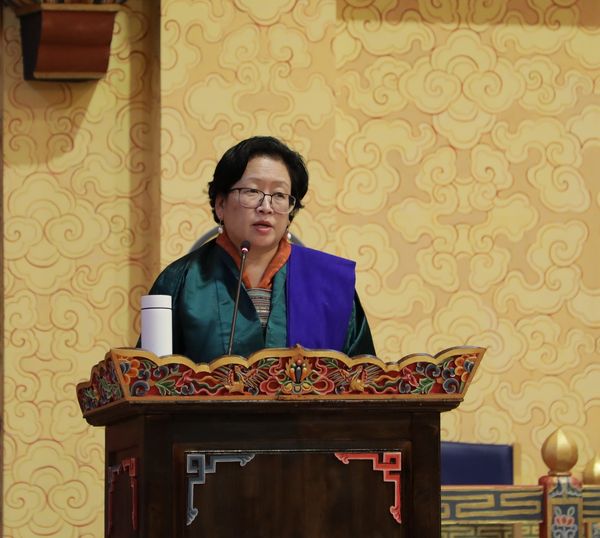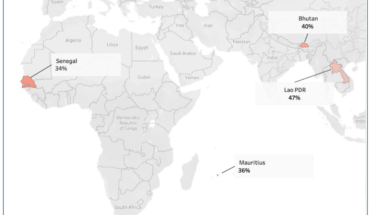Paints media in dire hues and said it needs immediate interventions

PEMA TSHOMO
Thimphu
The Social and Cultural Affairs Committee (SCAC) of the National Council on 29 Nov presented its review report on the State of Media in Bhutan. The committee recognized the need for this review following His Majesty the King’s Royal Kasho granted to the Bhutan Media Foundation on 21st February 2010, which emphasized the media’s essential role in fostering a vibrant democracy.
The Chairperson of the SCAC, Kesang Chuki Dorjee presented the report, which outlined its background, objectives, methodology, findings, and recommendations. The report aimed to review Bhutan’s media legislation, assess the impact of government interventions, and explore strategies to support independent journalism.
She noted Bhutan’s significant decline in the World Press Freedom Index, which fell from 33rd in 2021 to 147th in 2023, reflecting challenges in the political, legal, economic, and sociocultural landscapes.
She said from the Bhutan Broadcasting Service (BBS) to private print media, emerging over-the-top (OTT) platforms, and the pervasive influence of social media, Bhutan’s media ecosystem must navigate a delicate balance between financial sustainability, cultural preservation, and technological advancement.
The Bhutan Broadcasting Service Corporation Limited (BBS), established in 1973 as the country’s sole national broadcaster, embodies the country’s ambitions of providing trusted public service media. Starting as a radio station, BBS has expanded into a multi-platform entity, including two television channels and two radio channels broadcasting in multiple languages.
Despite its central role in promoting national unity and cultural preservation, BBS grapples with significant obstacles, ranging from financial instability to structural inefficiencies. While the delinking of BBS from the Ministry of Information and Communications in 1992 aimed to foster independence and professionalism, the organization’s reliance on government funding persists. This dependency, coupled with a mandate to generate commercial revenue, has created a tug-of-war between profitability and its public service obligations.
Moreover, recent performance audits have revealed systemic issues within BBS, including inadequate editorial policies, high employee turnover, and a lack of effective news management systems. A significant exodus of experienced professionals (87) in 2022 alone underscores the pressing need for a supportive working environment and strategic workforce planning.
Despite recommendations for a clear legal status as a Public Service Broadcaster (PSB), BBS continues to operate without the financial autonomy or legislative framework required to fulfill its public mandate effectively.
Private print media, once thriving, now faces its existential crises. Kuensel, the nation’s oldest newspaper, symbolizes the struggle for financial sustainability amidst declining circulation and advertising revenues. Government austerity measures and a saturated media market have exacerbated these challenges, leaving private newspapers heavily reliant on government advertisements, which account for nearly 90 percent of their income.
The high costs of printing and distribution, coupled with competition from digital platforms, have further diminished the viability of traditional print media. While proposals such as a Media Endowment Fund and government subsidies aim to alleviate these pressures, their implementation remains uncertain, leaving the long-term future of private newspapers in limbo.
One of the most pressing concerns in the nation’s media sector is the preservation of the Dzongkha language, a cornerstone of national identity. Despite multiple Royal Kashos and government policies emphasizing its importance, Dzongkha newspapers struggle to sustain themselves financially.
High production costs, low demand, and minimal advertising revenues have led to the closure of several Dzongkha publications, reducing their presence to a few pages in English newspapers or weekly editions. Efforts to digitize Dzongkha content and promote subscriptions among schools and government offices offer glimmers of hope, but these measures fall short of addressing the systemic challenges faced by Dzongkha media.
Whereas, emerging digital platforms and over-the-top (OTT) services, such as SAMUH and Shangreela, represent a new frontier for Bhutanese media. These platforms have the potential to showcase Bhutan’s unique culture and storytelling to a global audience.
However, outdated intellectual property laws and inconsistent regulatory frameworks hinder their growth. Copyright infringement remains rampant, with SAMUH alone filing 50 cases in the past year.
Additionally, the lack of payment gateways and high internet costs undermine the subscription-based models that are vital for the survival of these platforms. Without a robust venture capital framework or access to film grants, Bhutan’s creative industry struggles to realize its full potential, even as internationally acclaimed films like Lunana: A Yak in the Classroom highlight the possibilities.
The rapid proliferation of social media has further transformed Bhutan’s media landscape, offering both opportunities and challenges. With approximately 90 percent of Bhutanese active on at least one platform, social media has become a primary source of information and entertainment.
Citizen journalism and digital content creation are on the rise, empowering individuals to share stories and perspectives. However, the spread of misinformation, cyberbullying, and digital addiction pose significant risks, particularly for younger audiences.
A recent study revealed that 40 percent of high school students experience moderate to severe internet addiction, underscoring the urgent need for a National Digital Media Literacy Policy. While various government agencies and civil society organizations have implemented piecemeal initiatives to address these issues, a unified and comprehensive strategy remains elusive.
For BBS, this means embracing its role as a true Public Service Broadcaster, independent of government influence and equipped with the financial and legislative support needed to prioritize public interest.
For private media, diversification into digital platforms and innovative revenue models, supported by government policies, can help mitigate financial pressures. Strengthening intellectual property laws and fostering a supportive environment for OTT platforms will enable Bhutanese content creators to thrive in a competitive digital economy.





